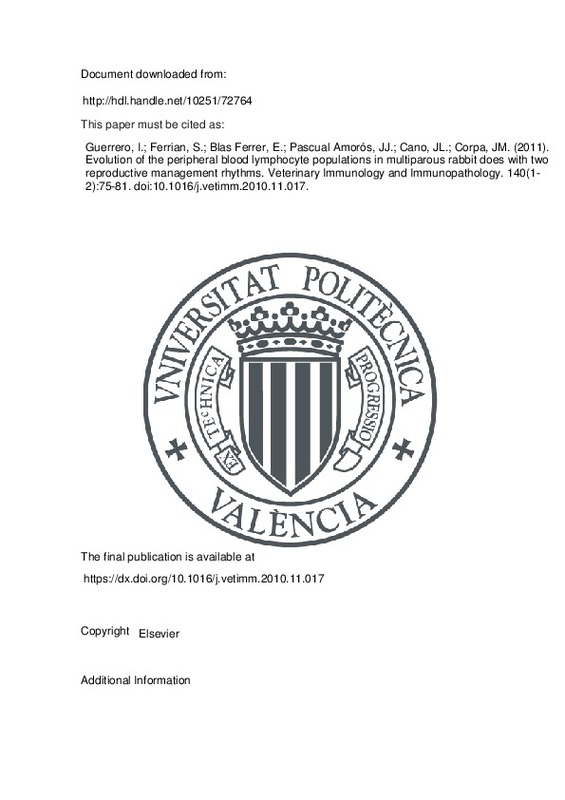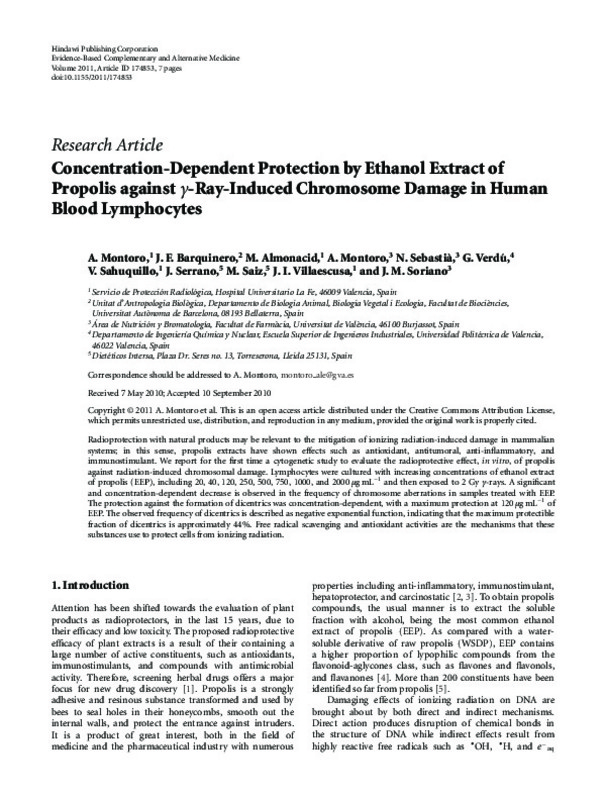JavaScript is disabled for your browser. Some features of this site may not work without it.
Buscar en RiuNet
Listar
Mi cuenta
Estadísticas
Ayuda RiuNet
Admin. UPV
Evolution of the peripheral blood lymphocyte populations in multiparous rabbit does with two reproductive management rhythms
Mostrar el registro sencillo del ítem
Ficheros en el ítem
| dc.contributor.author | Guerrero, Irene
|
es_ES |
| dc.contributor.author | Ferrian, Selena
|
es_ES |
| dc.contributor.author | Blas Ferrer, Enrique
|
es_ES |
| dc.contributor.author | Pascual Amorós, Juan José
|
es_ES |
| dc.contributor.author | Cano, Jose L.
|
es_ES |
| dc.contributor.author | Corpa, Juan M.
|
es_ES |
| dc.date.accessioned | 2016-10-26T07:29:40Z | |
| dc.date.available | 2016-10-26T07:29:40Z | |
| dc.date.issued | 2011-03-15 | |
| dc.identifier.issn | 0165-2427 | |
| dc.identifier.uri | http://hdl.handle.net/10251/72764 | |
| dc.description.abstract | The emergence of epizootic rabbit enteropathy is leading to changes in weaning protocols in commercial rabbitries. Traditional weaning protocols are being replaced with late weaning, beyond 35 days postpartum (dpp). The main objectives of this study were to compare the peripheral blood lymphocyte populations of multiparous rabbit does under two reproductive rhythms (insemination at 11 dpp and weaning at 28 dpp, insemination at 25 dpp and weaning at 42 dpp), and to assess the influence on those of kits. Samples of peripheral blood were taken in 22 adult females and 44 of their kits at different critical times, and several lymphocytic populations were evaluated by flow cytometry. Additionally, the perirenal fat thickness of does was also measured at partum and weaning to observe if body condition correlates with lymphocyte populations. During whole lactation, counts of total, CD5 +, CD4 + and CD8 + lymphocytes of females were generally lower with weaning at 42 dpp compared to 28 dpp. Moreover, counts of total, B and CD5 + lymphocytes in rabbit does weaned at 42 dpp correlated to their body condition (+0.60 to 0.82; P<0.05), contrary to that observed in rabbit does weaned at 28 dpp. Some correlations between lymphocyte counts in both groups of does and weaning rabbits were observed. At weaning, those young rabbits weaned at 42 dpp had a significantly lower number of CD4 + lymphocytes than those weaned at 28 dpp (P<0.01). In conclusion, the 42 ddp rabbit does presented a lower number of total lymphocytes and lymphocytic subpopulations during lactation and at weaning, as well as lesser capacity of adjustment during the gestation-lactation cycle. © 2010 Elsevier B.V. | es_ES |
| dc.description.sponsorship | This study has been supported by grants from the CEU-Cardenal Herrera University (Banco Santander/CEU-UCH: Copernicus Program (PRCEU-UCH/COOP 01/08), Generalitat Valenciana (ACOMP/2009/207 and ACOMP/2010/062) and the Comision Interministerial de Ciencia y Tecnologia (AGL2008-00273/GAN). Grants for Selena Ferrian and Irene Guerrero from Generalitat Valenciana (the Santiago Grisolia programme) and from the CEU-Cardenal Herrera University, respectively, are gratefully acknowledged. | en_EN |
| dc.language | Inglés | es_ES |
| dc.publisher | Elsevier | es_ES |
| dc.relation.ispartof | Veterinary Immunology and Immunopathology | es_ES |
| dc.rights | Reserva de todos los derechos | es_ES |
| dc.subject | Body condition | es_ES |
| dc.subject | Flow cytometry | es_ES |
| dc.subject | Lymphocytic populations | es_ES |
| dc.subject | Peripheral blood | es_ES |
| dc.subject | Rabbit | es_ES |
| dc.subject | Weaning age | es_ES |
| dc.subject | CD5 antigen | es_ES |
| dc.subject | Article | es_ES |
| dc.subject | Artificial insemination | es_ES |
| dc.subject | B lymphocyte | es_ES |
| dc.subject | Blood sampling | es_ES |
| dc.subject | CD4+ T lymphocyte | es_ES |
| dc.subject | CD8+ T lymphocyte | es_ES |
| dc.subject | Clinical article | es_ES |
| dc.subject | Experimental rabbit | es_ES |
| dc.subject | Female | es_ES |
| dc.subject | Human | es_ES |
| dc.subject | Lactation | es_ES |
| dc.subject | Lymphocyte count | es_ES |
| dc.subject | Lymphocyte subpopulation | es_ES |
| dc.subject | Multipara | es_ES |
| dc.subject | Peripheral lymphocyte | es_ES |
| dc.subject | Weaning | es_ES |
| dc.subject | Oryctolagus cuniculus | es_ES |
| dc.subject.classification | PRODUCCION ANIMAL | es_ES |
| dc.subject.classification | NUTRICION Y BROMATOLOGIA | es_ES |
| dc.title | Evolution of the peripheral blood lymphocyte populations in multiparous rabbit does with two reproductive management rhythms | es_ES |
| dc.type | Artículo | es_ES |
| dc.identifier.doi | 10.1016/j.vetimm.2010.11.017 | |
| dc.relation.projectID | info:eu-repo/grantAgreement/Universidad CEU Cardenal Herrera//PRCEU-UCH%2FCOOP 01%2F08/ | es_ES |
| dc.relation.projectID | info:eu-repo/grantAgreement/Generalitat Valenciana//ACOMP%2F2009%2F207/ES/IDENTIFICACIÓN DE FACTORES DE PATOGENICIDAD Y CARACTERIZACIÓN INMUNOPATOLÓGICA DE SU EFECTO EN MAMITIS CUNÍCOLAS PROVOCADAS POR Staphylococcus aureus./ | es_ES |
| dc.relation.projectID | info:eu-repo/grantAgreement/GVA//ACOMP%2F2010%2F062/ | es_ES |
| dc.relation.projectID | info:eu-repo/grantAgreement/MICINN//AGL2008-00273/ES/IDENTIFICACION DE FACTORES DE PATOGENICIDAD Y CARACTERIZACION INMUNOPATOLOGICA DE SU EFECTO EN MAMITIS CUNICOLAS PROVOCADAS POR STAPHYLOCOCCUS AUREUS./ | es_ES |
| dc.rights.accessRights | Abierto | es_ES |
| dc.contributor.affiliation | Universitat Politècnica de València. Departamento de Ciencia Animal - Departament de Ciència Animal | es_ES |
| dc.description.bibliographicCitation | Guerrero, I.; Ferrian, S.; Blas Ferrer, E.; Pascual Amorós, JJ.; Cano, JL.; Corpa, JM. (2011). Evolution of the peripheral blood lymphocyte populations in multiparous rabbit does with two reproductive management rhythms. Veterinary Immunology and Immunopathology. 140(1-2):75-81. https://doi.org/10.1016/j.vetimm.2010.11.017 | es_ES |
| dc.description.accrualMethod | S | es_ES |
| dc.relation.publisherversion | https://dx.doi.org/10.1016/j.vetimm.2010.11.017 | es_ES |
| dc.description.upvformatpinicio | 75 | es_ES |
| dc.description.upvformatpfin | 81 | es_ES |
| dc.type.version | info:eu-repo/semantics/publishedVersion | es_ES |
| dc.description.volume | 140 | es_ES |
| dc.description.issue | 1-2 | es_ES |
| dc.relation.senia | 41124 | es_ES |
| dc.contributor.funder | Generalitat Valenciana | es_ES |
| dc.contributor.funder | Ministerio de Ciencia e Innovación | es_ES |
| dc.contributor.funder | Universidad CEU Cardenal Herrera | es_ES |







![[Cerrado]](/themes/UPV/images/candado.png)



